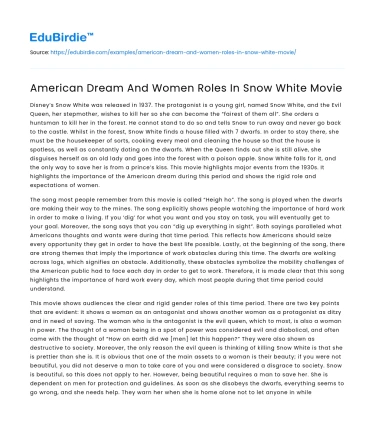Disney’s Snow White was released in 1937. The protagonist is a young girl, named Snow White, and the Evil Queen, her stepmother, wishes to kill her so she can become the “fairest of them all”. She orders a huntsman to kill her in the forest. He cannot stand to do so and tells Snow to run away and never go back to the castle. Whilst in the forest, Snow White finds a house filled with 7 dwarfs. In order to stay there, she must be the housekeeper of sorts, cooking every meal and cleaning the house so that the house is spotless, as well as constantly doting on the dwarfs. When the Queen finds out she is still alive, she disguises herself as an old lady and goes into the forest with a poison apple. Snow White falls for it, and the only way to save her is from a prince’s kiss. This movie highlights major events from the 1930s. It highlights the importance of the American dream during this period and shows the rigid role and expectations of women.
The song most people remember from this movie is called “Heigh ho”. The song is played when the dwarfs are making their way to the mines. The song explicitly shows people watching the importance of hard work in order to make a living. If you ‘dig’ for what you want and you stay on task, you will eventually get to your goal. Moreover, the song says that you can “dig up everything in sight”. Both sayings paralleled what Americans thoughts and wants were during that time period. This reflects how Americans should seize every opportunity they get in order to have the best life possible. Lastly, at the beginning of the song, there are strong themes that imply the importance of work obstacles during this time. The dwarfs are walking across logs, which signifies an obstacle. Additionally, these obstacles symbolize the mobility challenges of the American public had to face each day in order to get to work. Therefore, it is made clear that this song highlights the importance of hard work every day, which most people during that time period could understand.
Save your time!
We can take care of your essay
- Proper editing and formatting
- Free revision, title page, and bibliography
- Flexible prices and money-back guarantee
This movie shows audiences the clear and rigid gender roles of this time period. There are two key points that are evident: it shows a woman as an antagonist and shows another woman as a protagonist as ditzy and in need of saving. The woman who is the antagonist is the evil queen, which to most, is also a woman in power. The thought of a woman being in a spot of power was considered evil and diabolical, and often came with the thought of “How on earth did we [men] let this happen?” They were also shown as destructive to society. Moreover, the only reason the evil queen is thinking of killing Snow White is that she is prettier than she is. It is obvious that one of the main assets to a woman is their beauty; if you were not beautiful, you did not deserve a man to take care of you and were considered a disgrace to society. Snow is beautiful, so this does not apply to her. However, being beautiful requires a man to save her. She is dependent on men for protection and guidelines. As soon as she disobeys the dwarfs, everything seems to go wrong, and she needs help. They warn her when she is home alone not to let anyone in while they are at work in the mines. The Queen tries to harm her three times, first with an extremely laced up bodice, then with a poisoned comb, and then with a poisoned apple. The first two times, Snow White faints but is saved in time by the dwarfs. The last time, she passes out, and the dwarfs assume that she is dead. If she listened to the dwarfs, the movie makes it clear that this could have been completely avoided. Additionally, Snow is portrayed as only knowing how to do certain tasks, like cleaning and maintaining the household as well as taking care of her “men” when they return from work each day.
This was since the role of homemakers was enlarged because of the Great Depression. During the war, women had a chance to work outside of the house, but when they came back, the women had to go back to doing their regular jobs. This left them feeling upset and demanding equal rights, such as the right to vote, which they did get in 1918. Thus, this movie illustrates women’s roles in the 1920s, such as looking beautiful and doing housework.






 Stuck on your essay?
Stuck on your essay?

